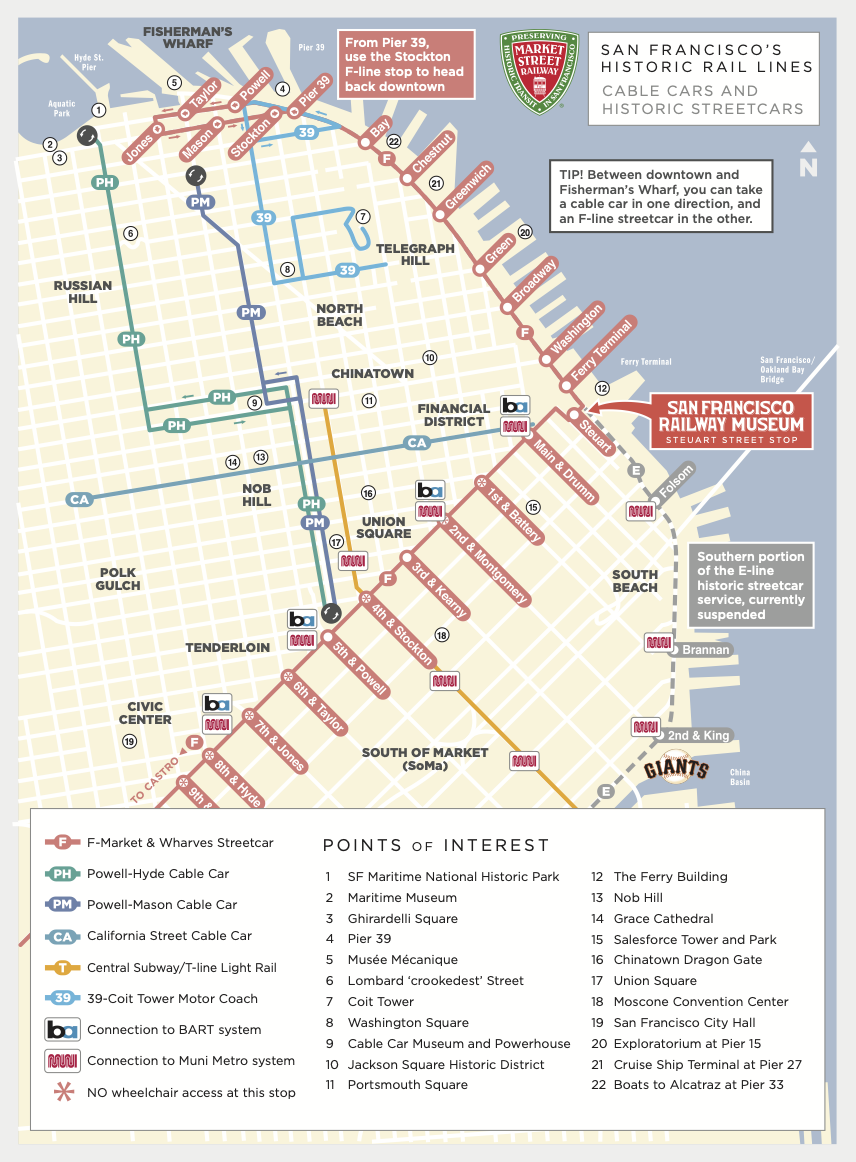San Francisco is the only place in the world you can ride cable cars like this. They take you to great places with spectacular views along the way.
Here’s our guide to historic sites along the cable car routes.
Here’s our unbiased guide for historic drinking and dining.
Here’s a basic Q&A about the cable cars.
Ride the cable cars
The downtown terminals of all three lines are right next to stations for BART and Muni Metro, the modern underground rail services that cover the City and Bay Area. Details on what you’ll see on each route below.
When do cable cars run and who runs them?
Cable cars operate every day of the year, currently from 7 a.m. to 11 p.m. The best way to avoid waiting in line to ride is to go before 9 a.m. or after 8 p.m. The Powell lines are more crowded than the California line, where you can get on without waiting almost any time of the day. The San Francisco Municipal Transportation Agency (Muni) owns and operates the cable cars, along with the vintage “F-line” streetcars on Market Street and the waterfront, and the City’s light rail and bus system.
How much does it cost and where can I pay?
A single cable car ride costs $8 one way for all riders over age 4. No transfers are issued or accepted. You must purchase tickets at the kiosks and ticket machines at the terminals. If boarding along the lines, you may pay the conductor in cash. (Conductors cannot make change.)
BARGAIN ALERT: If you’re taking multiple transit rides, a much better value is the one-day Muni Passport. For just $13, you get a full day of unlimited Muni rides, including all the cable car lines, the F-line historic streetcars on the waterfront and Market Street, the Muni Metro subway trains, and all Muni buses. It’s available at those kiosks and ticket machines at the cable car terminals as well as on the Muni Mobile app. The one-day $13 Muni Passport costs just $5 more than a single cable car ride. (There are 3-day and 7-day Passports available as well.)
Muni’s city-wide service can take you to great destinations, including the Golden Gate Bridge, Golden Gate Park, the national park at The Presidio, Ocean Beach, and many more.
You can also use the regional Clipper Card on the cable cars, but you’ll pay $8 per ride. If you’re paying cash, you can buy tickets at the ends of the Powell lines, or pay the conductor on all cable cars. Here’s full information on fare options.
(NOTE: For the 150th anniversary year, a special $5 fare was in effect on the California Street cable car line through the end of 2023. This was very popular, and Muni is working to re-instate it permanently by mid-2024. For now, the California Street fare is the same as Powell Street: $8 one-way.
What will I see along the way?
California Street line
The oldest surviving cable car line (opened in 1878) runs east-west along California Street. It starts at Market Street, next to the Hyatt Regency Hotel, two blocks west of the Ferry Building. The California cable cars roll through the imposing Financial District past historic restaurants and buildings interspersed with modern high-rises. Then they climb Nob Hill through Chinatown, cross the other cable car lines at Powell Street, and top out at Grace Cathedral, an imposing and beautiful building inside and out. From there, it’s downhill to reach Polk Gulch, an interesting shopping area, ending at Van Ness Avenue, the City’s main north-south boulevard.
Powell Street lines
The other two cable car lines, Mason and Hyde, start together at Powell and Market Streets, next to the plaza named for cable car inventor Andrew Hallidie. They head north, running through the City’s premier shopping area, Union Square, then climb Nob Hill to cross the California Street cable line at the crest and continuing north on Powell Street four more blocks along the western edge of Chinatown.
Then, the two lines turn left onto narrow Jackson Street and diverge. The Mason line continues one block west of Powell, running north along on Mason along the edge of the colorful North Beach neighborhood, then cutting diagonally along Columbus Avenue to reach Taylor Street and the terminal at Bay Street, at the southern edge of Fisherman’s Wharf. The Hyde line follows Jackson Street (Washington Street in the other direction) four more blocks to reach Hyde, then turns north through a scenic tree tunnel past shops and restaurants on Russian Hill. At the top, it passes the “Crookedest Street in the World” (Lombard Street), then descends the steepest grade in the cable system to reach its terminal at Beach Street in Aquatic Park, part of San Francisco Maritime National Historical Park, in the western part of Fisherman’s Wharf. Ghirardelli Square is one block to the west.
Muni’s historic streetcar line, the F-Market & Wharves, connects terminals of all three cable car lines, making it easy to use a cable car in one direction, a vintage streetcar in the other between Downtown and Fisherman’s Wharf . Unlimited streetcar rides are included with the Muni Mobile passports. Cash fare on the streetcars is $3, same as buses and Muni trains.
Where do the cable cars run?
There are three cable car lines, all located in the northeast section of San Francisco. Here’s a map.

